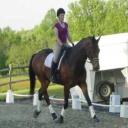Yahoo Answers is shutting down on May 4th, 2021 (Eastern Time) and beginning April 20th, 2021 (Eastern Time) the Yahoo Answers website will be in read-only mode. There will be no changes to other Yahoo properties or services, or your Yahoo account. You can find more information about the Yahoo Answers shutdown and how to download your data on this help page.
Trending News
Counter canter and flying lead changes; we're having some issues =D?
My pony has never done much work on counter canter so I though I would start some now as we now have a rather nice balanced normal canter.
So I started off with some shallow loops and she was very confused at first but got it after a while and after about 15 minutes she had adjusted and was balanced in them! :D
So I moved on to doing some figure of eights to get her to be in counter canter for a few strides at the end of the diagonal. She picked it up after a while but was rushing quite a lot which put her a little off balance.
1) How can I stop the rushing without her breaking back into trot? (I know it sounds like a silly question but she won't stop rushing!)
Also, at the end I started asking for a flying change (just to see if she would do it; I know I shouldn't have really :S) and she actually did it, but only changed up in her back legs and not the front. So we ended up on this odd, bouncy (yet balanced) two-track canter!
2) What are the correct aids for a flying change?
3) How can I make sure she changes up fully?
Thanks for any help guys!
xx
6 Answers
- AngelaLv 61 decade agoFavorite Answer
It sounds like you had such good success with introducing the counter canter on shallow loops, that you got a bit over-eager and rushed through the rest of the training. Counter-canter is not as easy as it appears; it requires quite a bit of collection and excellent balance. Just go back to working on the counter canter in shallow loops and only gradually over many months make the exercise more challenging. I used to lease a Grand Prix dressage schoolmaster, and I had a hard time with counter canter in a figure-8 pattern on him!
When your pony starts rushing, it's a sign that she's lost her balance and fallen on the forehand. She doesn't lose her balance because she's rushing, she's rushing because she lost her balance! The solution is half-halts to rock her weight back onto her hindquarters and maintain collection. If she's breaking into trot when you half-halt then you are using too much rein and not enough leg and seat. Keep working on exercises in all gaits to improve collection and self-carriage, not just the canter. Transitions, lateral work, etc.
It sounds like your pony is not ready for work on flying changes. Many people introduce the changes WAY too early in a horse's training, before the horse has sufficient strength and balance, and RUIN their horse's changes. When your horse only changes leads behind and not in front, that's a sign that you are not ready. Flying changes are tricky- once a horse learns to do them badly, it's nearly impossible to go back and fix them to make them clean. You really need to work with an experienced trainer to introduce flying changes to your pony.
I know flying changes are really fun, but you'll just have to spend more time on your basics until you both are ready if you want to teach her correctly. If you can take a few lessons on a trained horse who can teach YOU the feeling of correct flying changes, that will help tremendously. The aids are the same as asking for canter normally, but the TIMING is difficult to learn. Unfortunately, there are no shortcuts with riding!
Source(s): Riding instructor - Anonymous1 decade ago
You are guaranteed to end up with a confused, upset pony if you try to work on counter-canter and flying changes at the same time. Counter-canter is an easier exercise, so start with that. Shallow loops should have been enough for one day. The thing to do once she got the hang of that would have been to put her away for the day.
Then over the next several weeks you continue with the loops, gradually making them deeper. Counter-canter requires horses to build muscle, and muscle only develops so fast, so you can't rush the progress. After a month or so, depending on your pony's natural balance, and how large your ring is, and how good a rider you are, you *might* be ready to do a figure 8 in canter/counter canter. Then you can continue working on other figures, like serpentines, and making your circles smaller in counter-canter.
In about 3 months you *might* be ready to begin work on counter-canter. At that time, you should stop all work in counter-canter so as not to confuse your pony. When the flying changes are confirmed and easy (another few months) then you can reintroduce counter-canter and you should be able to do either whenever you want.
So to answer your specific questions:
1.) Slow down! You were pushing for way too much on day one. She was rushing because you were overwhelming her ability to cope both physically and mentally.
2 and 3.) Come back and ask these in a few months, if you are ready then.
Source(s): www.DempseyTraining.com - sazzyLv 71 decade ago
Counter canter will come with time.
It takes a lot of balance and suppleness to get a horse to do a successful canter, it's like them learning how to get their balance in normal canter all over again - so a bit of counter canter each time you school will do her the world of good, until she's eventually balanced doing it.
As for the flying lead changes, don't do them until she's more balanced. If she's changing either in front or behind but not both, that's going to teach her some horrid habits. We got a horse at the school I work who had been trained with fake flying changes, he started striking off on the wrong leg, or disunited, and would often change front lead when cantering which was a nightmare to get him out of.
So forget asking her to do a full lead change, any horse can do a front or back lead change - but that's a sign of bad balance, not good balance, it takes a hell of a lot more to get a good lead change. If she's disunited she's not balanced.
Work on her getting a really short but bouncy collected canter, get her really working from behind to get her working well.
To start ontroducing her to full flying changes, when she balanced to figure eights in canter, come down to trot to staret with to change the bend and then ask for canter on the next bend, gradually build down the time spent in trot before canter until she's barely going into trot, then when she's got the idea, ask for a flying change on the x and see what happens.
The aid for a flying change, change the bend and use your outside leg on the new rein to ask her to change, it will take time - flying changes are very hard for most horses to learn, they involve a hell of a lot of balance to do it properly, but the last thing you want her to do is to start going disunited or changing back then front, it's not good for her.
- Anonymous1 decade ago
Hey. :)
I think you should probably go back first, and start with the flying changes first - try doing it over a pole to help your horse, and if you can get someone to watch to check if your horse changes the back legs too.
I'd only then move on to a counter canter, so that your horse will listen to you to decide whether to change legs or not. :)
Aids for change: Open the rein slightly on the side you want your horse to lead on. On that same side have your leg on the girth (and squeeze) and on the other side, behind the girth.
Just get someone to watch you if you're not sure if she's changing correctly.
*Remember, some horses just won't be very keen on changing. :)
Source(s): riding for years. (: - How do you think about the answers? You can sign in to vote the answer.
- Anonymous5 years ago
I trust the different solutions. you will be throwing him off stability or he could in simple terms get drained cantering on one lead ans change to maintain going. it is like lifting a weight with one hand at a time. while one arm receives drained you turn. I doubt he's in soreness. If he exchange into he'd refuse to canter OR be displaying an incredible variety of alternative indicators.
- FREEDOMLv 61 decade ago
1- half halts!
2- change of seat bones and leg position- so going across the diagonal shift your weight to the new inside, and put that seat bone forward, outside seatbone back, and that should put your legs into canter position
3- you should feel it..or have someone tell you. or look in a mirror (if uou have any in the arena)




